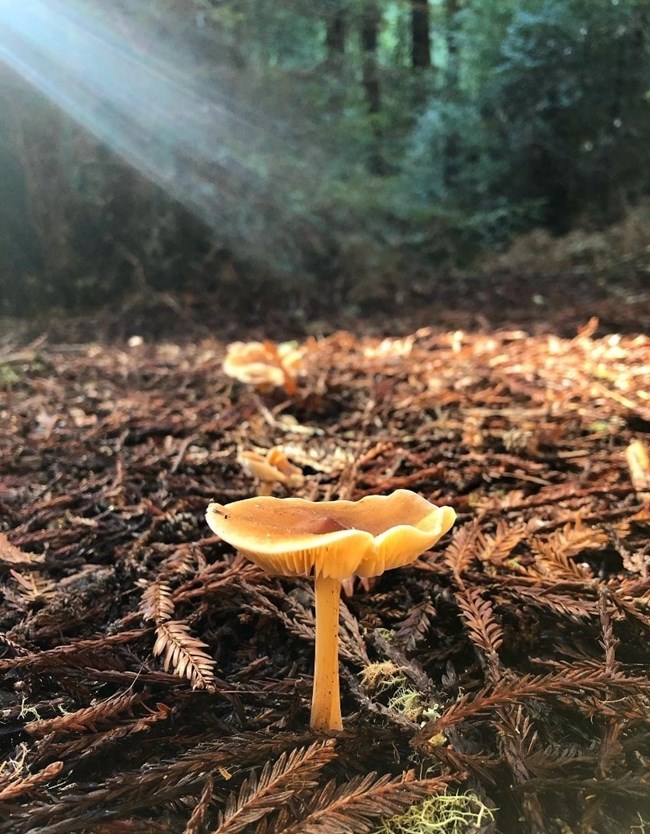
NPS What is a mushroom’s favorite thing to bring camping? S’pores!Mushrooms are the fruiting bodies of a fungus. Their job is to release spores to produce the next generation of fungus. They live for a short time and decay. The bulk of the organism is actually underground. It is made up of many root-like threads called hyphae. Many hyphae form a vast network called mycelium. 
Stephanie Weinstein/ NPS Caulorhiza umbonataCommon name: Redwood Rooter Description: Very common, and found scattered or solitary beneath redwood duff. Disc is smooth, sometimes upturned or wavy. Buff brown-to tawny brown disc. Cream colored gills. Ecology: You’ll find these early to mid-winter. These are one of the few species of fungi that you’ll find fruiting under redwood trees. Saphrophytic lifestyle decomposing (link to decomposers) decaying organic matter. These mushrooms look small, but the majority roots beneath the surface. It forms a taproot-like structure that can extend over 10 cm below, hence the name Redwood Rooter.

NPS Hygrocybe laetissimaCommon name: Cherry-Red Waxy Cap Description: Found scattered beneath the redwood duff. Scarlet to bright red cap. Gills that are whitish to yellow then pinkish and red with age. Yellow stripe with reddish base and surface covered in vertical striations. Ecology: Very common in Muir Woods in January and February. 
NPS Hericium erinaceusCommon name: Lion’s mane Description: Easily identified with drooping white spines that hang like a cluster of icicles. Turns yellowish-brownish as it ages. Ecology: Found on living hardwoods from late fall to mid-winter. Sapophytic lifestyle and parasitic (link.

NPS Marasmiellus candidusCommon name: Fairy Parachutes Description: Small, shining white or translucent white. Gills are few and far between, also white. Ecology: Often seen on twigs and logs throughout Redwood Creek. Grows on decaying hardwoods, usually in large groups. 
NPS Amanita muscariaCommon name: Fly Agaric or Fly Amanita Description: Your classic mushroom! Bright red to scarlet red cap, has warts that are usually white. Long white stalk. Ecology: Solitary or scattered, sometimes in large rings throughout the forest. Poisonous, best avoided. Mycorrhizal (link later) in hardwood forests.
Along with the mushroom species pictured above, there are over 200 species of mushrooms here at Muir Woods! This is by no means a comprehensive list, but here is a larger species list of some other mushrooms you can find within this enchanting redwood forest:
*It is important to note that mushroom foraging is not allowed at Muir Woods. Please use the information provided only as a resource about the kind of fungi that can be seen in the park. This information is not intended as an identification guide. It is not enough for identifying wild mushrooms to forage. Identifying wild mushrooms can be extremely difficult and can be deadly if done incorrectly. Please take only pictures of the beautiful mushrooms you see at Muir Woods. Let’s leave the fungi alone to continue their role in breaking down vital nutrients to nourish the redwoods.
For Further Reading:Arora, David. Mushrooms Demystified: a Comprehensive Guide to the Fleshy Fungi. Ten Speed Press, 1986.
“Fun Guide: Coolest, Weirdest Fungi to Spot in the Golden Gate National Parks.” Golden Gate National Parks Conservancy, 31 Jan. 2019, www.parksconservancy.org/article/fun-guide-coolest-weirdest-fungi-spot-golden-gate-national-parks. Katsaros, Peter. Familiar Mushrooms. Knopf, 1998. “See All M.O.M.s Hygrocybe Laetissima (Waxy Caps) (by Noah Siegel).” When It Rains, It Spores, 22 Jan. 2016, ffsc.us/MOM/2016/Waxy. Stamets, Paul. Mycelium Running: How Mushrooms Can Help Save the World. Ten Speed Press, 2005. |
Last updated: September 16, 2021
